check engine light Seat Ibiza 5D 2010 User Guide
[x] Cancel search | Manufacturer: SEAT, Model Year: 2010, Model line: Ibiza 5D, Model: Seat Ibiza 5D 2010Pages: 266, PDF Size: 7.04 MB
Page 187 of 266
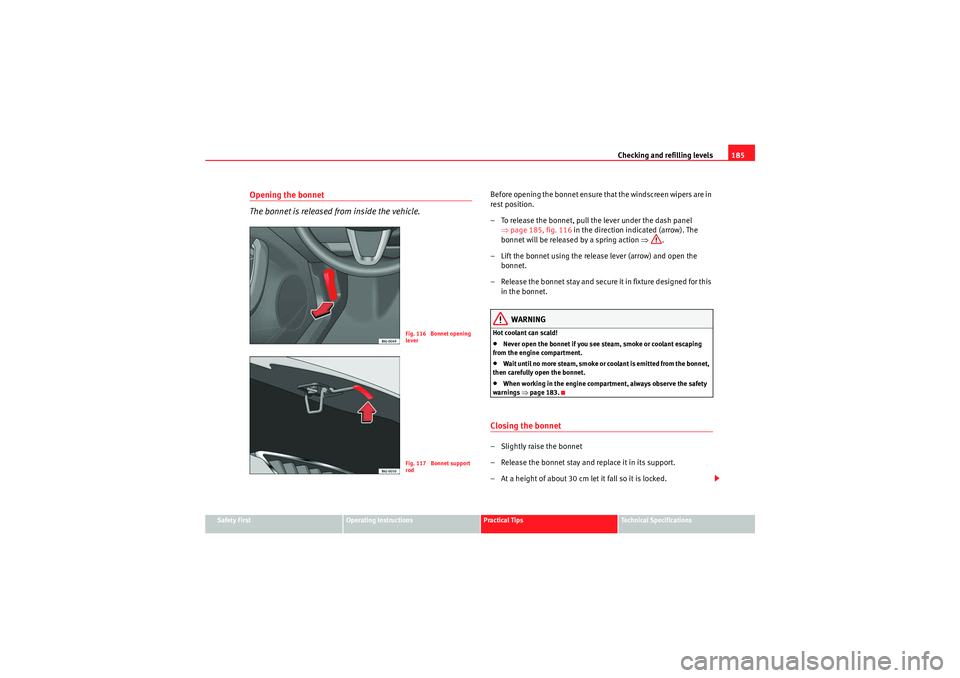
Checking and refilling levels185
Safety First
Operating Instructions
Practical Tips
Technical Specifications
Opening the bonnet
The bonnet is released from inside the vehicle.
Before opening the bonnet ensure that the windscreen wipers are in
rest position.
– To release the bonnet, pull the lever under the dash panel
⇒page 185, fig. 116 in the direction indicated (arrow). The
bonnet will be released by a spring action ⇒.
– Lift the bonnet using the release lever (arrow) and open the bonnet.
– Release the bonnet stay and secure it in fixture designed for this
in the bonnet.
WARNING
Hot coolant can scald!•Never open the bonnet if you see steam, smoke or coolant escaping
from the engine compartment.•Wait until no more steam, smoke or coolant is emitted from the bonnet,
then carefully open the bonnet.•When working in the engine compartment, always observe the safety
warnings ⇒page 183.
Closing the bonnet– Slightly raise the bonnet
– Release the bonnet stay and replace it in its support.
– At a height of about 30 cm let it fall so it is locked.
Fig. 116 Bonnet opening
leverFig. 117 Bonnet support
rod
Ibiza_EN.book Seite 185 Mittwoch, 1. September 2010 5:24 17
Page 194 of 266

Checking and refilling levels
192
Caution•If you notice a change in the colour of the liquid because it has been in
use for a long time, it is re commended to change it, as it will have lost some
of its properties and could cause damage to the vehicle.•If a lot of coolant fluid has been lost, wait for the engine to cool down
before putting in cold coolant. This avoids damaging the engine. Large
coolant losses are an indication of leaks in the cooling system. See a special-
ised workshop immediately and have the cooling system checked. Other-
wise, there is a risk of engine damage.Washer fluid and windscreen wiper bladesTopping up washer fluid
�Y
The water for cleaning the windscreen should always be
mixed with washer fluid.
The windscreen washer and the headlight washers are supplied with fluid
from the windscreen washer fluid container in the engine compartment. The
container holds approx. 2 litres; in vehicles with headlight washers* it holds
approx. 4.5 litres.
The reservoir is located on the right-hand side of the engine compartment.
Plain water is not enough to clean th e windscreen and headlights. We recom-
mend that you always add a product to the windscreen washer fluid.
Approved windscreen cleaning products exist on the market with high deter-
gent and anti-freeze properties, these may be added all-year-round. Please
follow the dilution instructions on the packaging.
WARNING
Any work carried out in the engine compartment or on the engine must be
carried out cautiously.•When working in the engine compartment, always observe the safety
warnings ⇒page 183.Caution
•Never put radiator anti-freeze or other additives into the windscreen
washer fluid.•Always use approved windscreen cleansing products diluted as per
instructions. If you use other washer fluids or soap solutions, the tiny holes
in the fan-shaped nozzles could become blocked.
Fig. 121 In the engine
compartment: Cap of
windscreen washer fluid
reservoir.
Ibiza_EN.book Seite 192 Mittwoch, 1. September 2010 5:24 17
Page 197 of 266
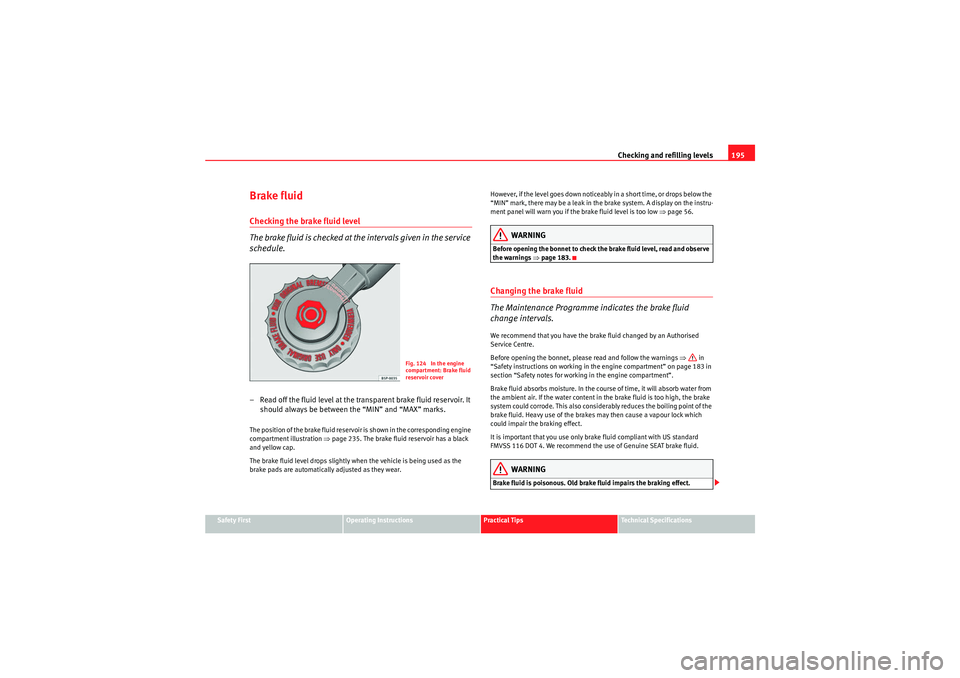
Checking and refilling levels195
Safety First
Operating Instructions
Practical Tips
Technical Specifications
Brake fluidChecking the brake fluid level
The brake fluid is checked at the intervals given in the service
schedule.– Read off the fluid level at the transparent brake fluid reservoir. It
should always be between the “MIN” and “MAX” marks.The position of the brake fluid reservoir is shown in the corresponding engine
compartment illustration ⇒page 235. The brake fluid reservoir has a black
and yellow cap.
The brake fluid level drops slightly when the vehicle is being used as the
brake pads are automatically adjusted as they wear. However, if the level goes down noticeably in a short time, or drops below the
“MIN” mark, there may be a leak in the brake system. A display on the instru-
ment panel will warn you if the brake fluid level is too low
⇒page 56.
WARNING
Before opening the bonnet to check the brake fluid level, read and observe
the warnings ⇒page 183.Changing the brake fluid
The Maintenance Programme indicates the brake fluid
change intervals.We recommend that you have the brake fluid changed by an Authorised
Service Centre.
Before opening the bonnet, please read and follow the warnings ⇒ in
“Safety instructions on working in the engine compartment” on page 183 in
section “Safety notes for working in the engine compartment”.
Brake fluid absorbs moisture. In the course of time, it will absorb water from
the ambient air. If the water content in the brake fluid is too high, the brake
system could corrode. This also considerably reduces the boiling point of the
brake fluid. Heavy use of the brakes may then cause a vapour lock which
could impair the braking effect.
It is important that you use only brake fluid compliant with US standard
FMVSS 116 DOT 4. We recommend the use of Genuine SEAT brake fluid.
WARNING
Brake fluid is poisonous. Old brake fluid impairs the braking effect.
Fig. 124 In the engine
compartment: Brake fluid
reservoir cover
Ibiza_EN.book Seite 195 Mittwoch, 1. September 2010 5:24 17
Page 199 of 266
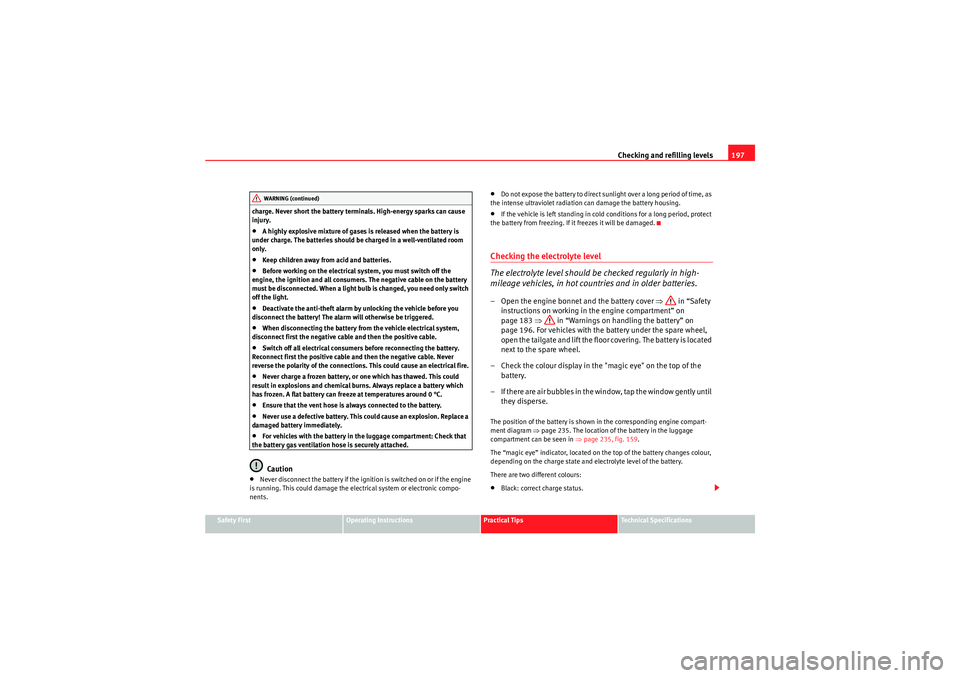
Checking and refilling levels197
Safety First
Operating Instructions
Practical Tips
Technical Specifications
charge. Never short the battery terminals. High-energy sparks can cause
injury.
•A highly explosive mixture of gases is released when the battery is
under charge. The batteries should be charged in a well-ventilated room
only.•Keep children away from acid and batteries.•Before working on the electrical system, you must switch off the
engine, the ignition and all consumers. The negative cable on the battery
must be disconnected. When a light bulb is changed, you need only switch
off the light.•Deactivate the anti-theft alarm by unlocking the vehicle before you
disconnect the battery! The alarm will otherwise be triggered.•When disconnecting the battery from the vehicle electrical system,
disconnect first the negative cable and then the positive cable.•Switch off all electrical consumers before reconnecting the battery.
Reconnect first the positive cable and then the negative cable. Never
reverse the polarity of the connections. This could cause an electrical fire.•Never charge a frozen battery, or one which has thawed. This could
result in explosions and chemical burns. Always replace a battery which
has frozen. A flat battery can freeze at temperatures around 0 °C.•Ensure that the vent hose is always connected to the battery.•Never use a defective battery. This could cause an explosion. Replace a
damaged battery immediately.•For vehicles with the battery in the luggage compartment: Check that
the battery gas ventilation hose is securely attached.Caution
•Never disconnect the battery if the ignition is switched on or if the engine
is running. This could damage the electrical system or electronic compo-
nents.
•Do not expose the battery to direct sunlight over a long period of time, as
the intense ultraviolet radiation can damage the battery housing.•If the vehicle is left standing in cold conditions for a long period, protect
the battery from freezing. If it freezes it will be damaged.Checking the electrolyte level
The electrolyte level should be checked regularly in high-
mileage vehicles, in hot countries and in older batteries.– Open the engine bonnet and the battery cover ⇒ in “Safety
instructions on working in the engine compartment” on
page 183 ⇒ in “Warnings on handling the battery” on
page 196. For vehicles with the battery under the spare wheel,
open the tailgate and lift the floor covering. The battery is located
next to the spare wheel.
– Check the colour display in the "magic eye" on the top of the battery.
– If there are air bubbles in the window, tap the window gently until they disperse.The position of the battery is shown in the corresponding engine compart-
ment diagram ⇒page 235. The location of the battery in the luggage
compartment can be seen in ⇒page 235, fig. 159 .
The “magic eye” indicator, located on the top of the battery changes colour,
depending on the charge state and electrolyte level of the battery.
There are two different colours:•Black: correct charge status.
WARNING (continued)
Ibiza_EN.book Seite 197 Mittwoch, 1. September 2010 5:24 17
Page 207 of 266
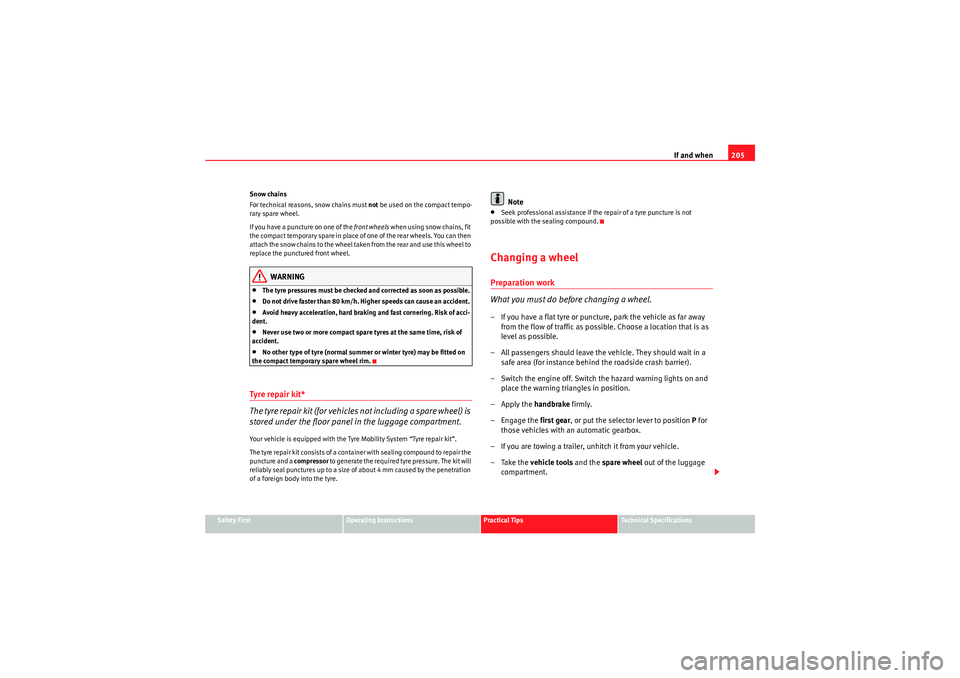
If and when205
Safety First
Operating Instructions
Practical Tips
Technical Specifications
Snow chains
For technical reasons, snow chains must
not be used on the compact tempo-
rary spare wheel.
If you have a puncture on one of the front wheels when using snow chains, fit
the compact temporary spare in place of one of the rear wheels. You can then
attach the snow chains to the wheel taken from the rear and use this wheel to
replace the punctured front wheel.
WARNING
•The tyre pressures must be checked and corrected as soon as possible.•Do not drive faster than 80 km/h. Higher speeds can cause an accident.•Avoid heavy acceleration, hard braking and fast cornering. Risk of acci-
dent.•Never use two or more compact spare tyres at the same time, risk of
accident.•No other type of tyre (normal summer or winter tyre) may be fitted on
the compact temporary spare wheel rim.
Tyre repair kit*
The tyre repair kit (for vehicles not including a spare wheel) is
stored under the floor panel in the luggage compartment.Your vehicle is equipped with the Tyre Mobility System “Tyre repair kit”.
The tyre repair kit consists of a container with sealing compound to repair the
puncture and a compressor to generate the required tyre pressure. The kit will
reliably seal punctures up to a size of about 4 mm caused by the penetration
of a foreign body into the tyre.
Note
•Seek professional assistance if the repair of a tyre puncture is not
possible with the sealing compound.Changing a wheelPreparation work
What you must do before changing a wheel.– If you have a flat tyre or puncture, park the vehicle as far away from the flow of traffic as possible. Choose a location that is as
level as possible.
– All passengers should leave the vehicle. They should wait in a safe area (for instance behind the roadside crash barrier).
– Switch the engine off. Switch the hazard warning lights on and place the warning triangles in position.
–Apply the handbrake firmly.
– Engage the first gear, or put the selector lever to position P for
those vehicles with an automatic gearbox.
– If you are towing a trailer, unhitch it from your vehicle.
– Take the vehicle tools and the spare wheel out of the luggage
compartment.
Ibiza_EN.book Seite 205 Mittwoch, 1. September 2010 5:24 17
Page 215 of 266
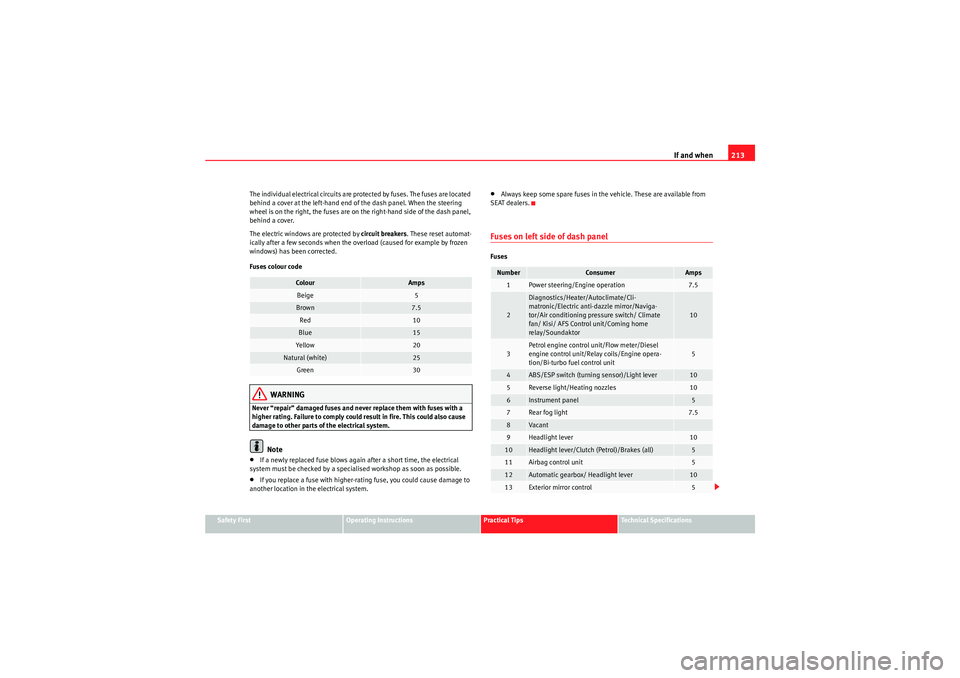
If and when213
Safety First
Operating Instructions
Practical Tips
Technical Specifications
The individual electrical circuits are protected by fuses. The fuses are located
behind a cover at the left-hand end of the dash panel. When the steering
wheel is on the right, the fuses are on the right-hand side of the dash panel,
behind a cover.
The electric windows are protected by
circuit breakers. These reset automat-
ically after a few seconds when the overload (caused for example by frozen
windows) has been corrected.
Fuses colour code
WARNING
Never “repair” damaged fuses and never replace them with fuses with a
higher rating. Failure to comply could result in fire. This could also cause
damage to other parts of the electrical system.
Note
•If a newly replaced fuse blows again after a short time, the electrical
system must be checked by a specialised workshop as soon as possible.•If you replace a fuse with higher-rating fuse, you could cause damage to
another location in the electrical system.
•Always keep some spare fuses in the vehicle. These are available from
SEAT dealers.Fuses on left side of dash panelFuses
Colour
Amps
Beige
5
Brown
7.5
Red
10
Blue
15
Ye l l o w
20
Natural (white)
25
Green
30
Number
Consumer
Amps
1
Power steering/Engine operation
7.5
2
Diagnostics/Heater/Autoclimate/Cli-
matronic/Electric anti-dazzle mirror/Naviga-
tor/Air conditioning pressure switch/ Climate
fan/ Kisi/ AFS Control unit/Coming home
relay/Soundaktor
10
3
Petrol engine control unit/Flow meter/Diesel
engine control unit/Relay coils/Engine opera-
tion/Bi-turbo fuel control unit
5
4
ABS/ESP switch (turning sensor)/Light lever
10
5
Reverse light/Heating nozzles
10
6
Instrument panel
5
7
Rear fog light
7.5
8
Va can t
9
Headlight lever
10
10
Headlight lever/Clutch (Petrol)/Brakes (all)
5
11
Airbag control unit
5
12
Automatic gearbox/ Headlight lever
10
13
Exterior mirror control
5
Ibiza_EN.book Seite 213 Mittwoch, 1. September 2010 5:24 17
Page 258 of 266
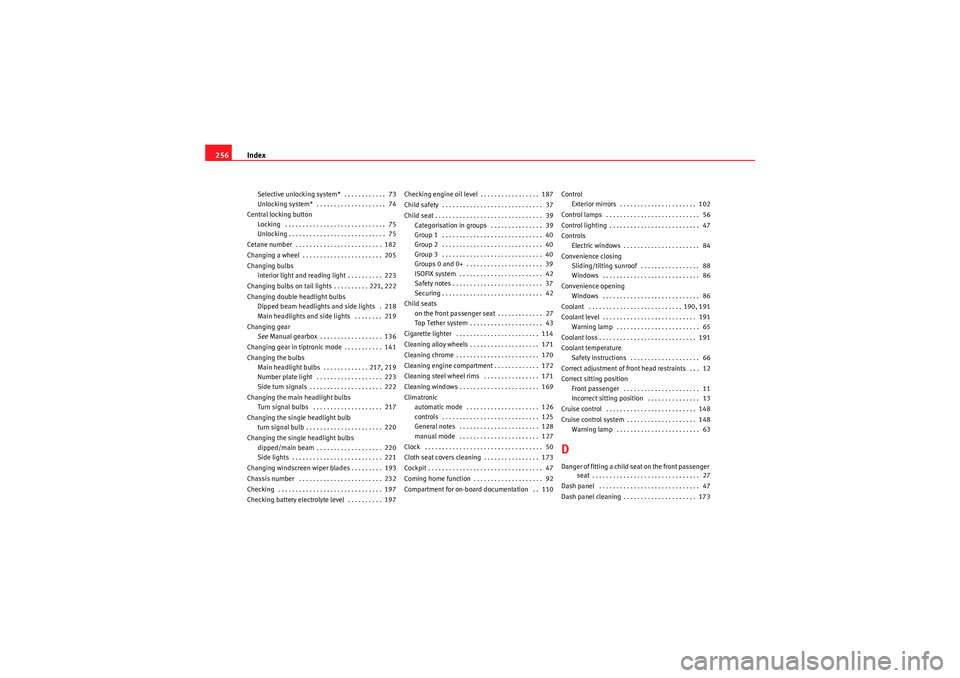
Index
256Selective unlocking system* . . . . . . . . . . . . 73
Unlocking system* . . . . . . . . . . . . . . . . . . . . 74
Central locking button Locking . . . . . . . . . . . . . . . . . . . . . . . . . . . . . 75
Unlocking . . . . . . . . . . . . . . . . . . . . . . . . . . . . 75
Cetane number . . . . . . . . . . . . . . . . . . . . . . . . . 182
Changing a wheel . . . . . . . . . . . . . . . . . . . . . . . 205
Changing bulbs interior light and reading light . . . . . . . . . . 223
Changing bulbs on tail lights . . . . . . . . . . 221, 222
Changing double headlight bulbs Dipped beam headlights and side lights . 218
Main headlights and side lights . . . . . . . . 219
Changing gear See Manual gearbox . . . . . . . . . . . . . . . . . . 136
Changing gear in tiptronic mode . . . . . . . . . . . 141
Changing the bulbs Main headlight bulbs . . . . . . . . . . . . . 217, 219
Number plate light . . . . . . . . . . . . . . . . . . . 223
Side turn signals . . . . . . . . . . . . . . . . . . . . . 222
Changing the main headlight bulbs Turn signal bulbs . . . . . . . . . . . . . . . . . . . . 217
Changing the single headlight bulb turn signal bulb . . . . . . . . . . . . . . . . . . . . . . 220
Changing the single headlight bulbs dipped/main beam . . . . . . . . . . . . . . . . . . . 220
Side lights . . . . . . . . . . . . . . . . . . . . . . . . . . 221
Changing windscreen wiper blades . . . . . . . . . 193
Chassis number . . . . . . . . . . . . . . . . . . . . . . . . 232
Checking . . . . . . . . . . . . . . . . . . . . . . . . . . . . . . 197
Checking battery electrolyte level . . . . . . . . . . 197 Checking engine oil level . . . . . . . . . . . . . . . . . 187
Child safety . . . . . . . . . . . . . . . . . . . . . . . . . . . . . 37
Child seat . . . . . . . . . . . . . . . . . . . . . . . . . . . . . . . 39
Categorisation in groups . . . . . . . . . . . . . . . 39
Group 1 . . . . . . . . . . . . . . . . . . . . . . . . . . . . . 40
Group 2 . . . . . . . . . . . . . . . . . . . . . . . . . . . . . 40
Group 3 . . . . . . . . . . . . . . . . . . . . . . . . . . . . . 40
Groups 0 and 0+ . . . . . . . . . . . . . . . . . . . . . . 39
ISOFIX system . . . . . . . . . . . . . . . . . . . . . . . . 42
Safety notes . . . . . . . . . . . . . . . . . . . . . . . . . . 37
Securing . . . . . . . . . . . . . . . . . . . . . . . . . . . . . 42
Child seats on the front passenger seat . . . . . . . . . . . . . 27
Top Tether system . . . . . . . . . . . . . . . . . . . . . 43
Cigarette lighter . . . . . . . . . . . . . . . . . . . . . . . . 114
Cleaning alloy wheels . . . . . . . . . . . . . . . . . . . . 171
Cleaning chrome . . . . . . . . . . . . . . . . . . . . . . . . 170
Cleaning engine compartment . . . . . . . . . . . . . 172
Cleaning steel wheel rims . . . . . . . . . . . . . . . . 171
Cleaning windows . . . . . . . . . . . . . . . . . . . . . . . 169
Climatronic automatic mode . . . . . . . . . . . . . . . . . . . . . 126
controls . . . . . . . . . . . . . . . . . . . . . . . . . . . . 125
General notes . . . . . . . . . . . . . . . . . . . . . . . 128
manual mode . . . . . . . . . . . . . . . . . . . . . . . 127
Clock . . . . . . . . . . . . . . . . . . . . . . . . . . . . . . . . . . 50
Cloth seat covers cleaning . . . . . . . . . . . . . . . . 173
Cockpit . . . . . . . . . . . . . . . . . . . . . . . . . . . . . . . . . 47
Coming home function . . . . . . . . . . . . . . . . . . . . 92
Compartment for on-board documentation . . 110 Control
Exterior mirrors . . . . . . . . . . . . . . . . . . . . . . 102
Control lamps . . . . . . . . . . . . . . . . . . . . . . . . . . . 56
Control lighting . . . . . . . . . . . . . . . . . . . . . . . . . . 47
Controls Electric windows . . . . . . . . . . . . . . . . . . . . . . 84
Convenience closing Sliding/tilting sunroof . . . . . . . . . . . . . . . . . 88
Windows . . . . . . . . . . . . . . . . . . . . . . . . . . . . 86
Convenience opening Windows . . . . . . . . . . . . . . . . . . . . . . . . . . . . 86
Coolant . . . . . . . . . . . . . . . . . . . . . . . . . . . 190, 191
Coolant level . . . . . . . . . . . . . . . . . . . . . . . . . . . 191 Warning lamp . . . . . . . . . . . . . . . . . . . . . . . . 65
Coolant loss . . . . . . . . . . . . . . . . . . . . . . . . . . . . 191
Coolant temperature Safety instructions . . . . . . . . . . . . . . . . . . . . 66
Correct adjustment of front head restraints . . . 12
Correct sitting position Front passenger . . . . . . . . . . . . . . . . . . . . . . 11
Incorrect sitting position . . . . . . . . . . . . . . . 13
Cruise control . . . . . . . . . . . . . . . . . . . . . . . . . . 148
Cruise control system . . . . . . . . . . . . . . . . . . . . 148 Warning lamp . . . . . . . . . . . . . . . . . . . . . . . . 63
DDanger of fitting a child seat on the front passenger seat . . . . . . . . . . . . . . . . . . . . . . . . . . . . . . . 27
Dash panel . . . . . . . . . . . . . . . . . . . . . . . . . . . . . 47
Dash panel cleaning . . . . . . . . . . . . . . . . . . . . . 173
Ibiza_EN.book Seite 256 Mittwoch, 1. September 2010 5:24 17
Page 259 of 266
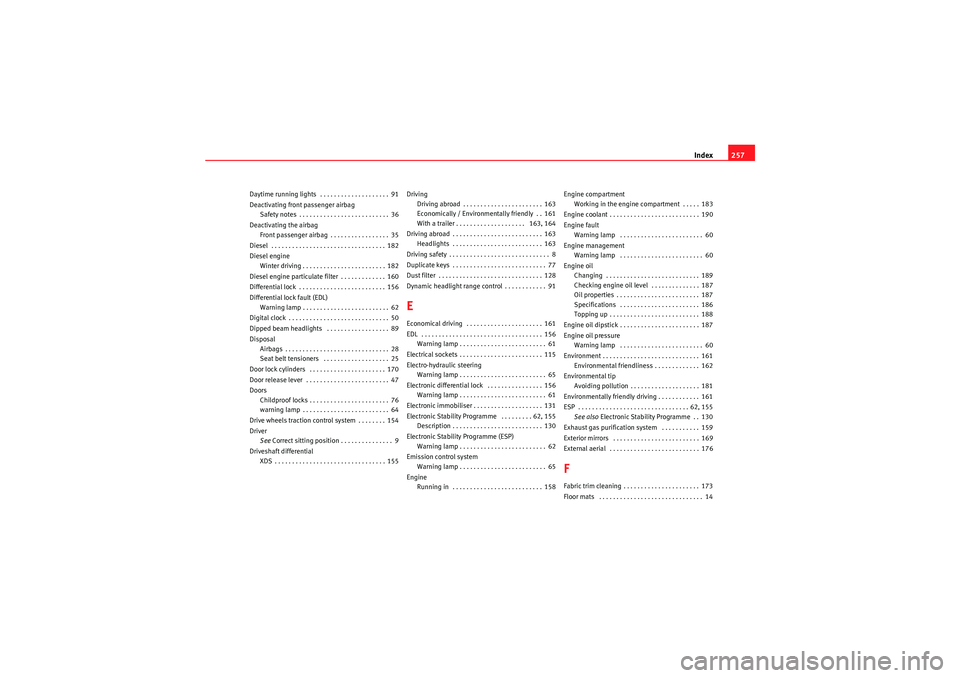
Index257
Daytime running lights . . . . . . . . . . . . . . . . . . . . 91
Deactivating front passenger airbag
Safety notes . . . . . . . . . . . . . . . . . . . . . . . . . . 36
Deactivating the airbag Front passenger airbag . . . . . . . . . . . . . . . . . 35
Diesel . . . . . . . . . . . . . . . . . . . . . . . . . . . . . . . . . 182
Diesel engine Winter driving . . . . . . . . . . . . . . . . . . . . . . . . 182
Diesel engine particulate filter . . . . . . . . . . . . . 160
Differential lock . . . . . . . . . . . . . . . . . . . . . . . . . 156
Differential lock fault (EDL) Warning lamp . . . . . . . . . . . . . . . . . . . . . . . . . 62
Digital clock . . . . . . . . . . . . . . . . . . . . . . . . . . . . . 50
Dipped beam headlights . . . . . . . . . . . . . . . . . . 89
Disposal Airbags . . . . . . . . . . . . . . . . . . . . . . . . . . . . . . 28
Seat belt tensioners . . . . . . . . . . . . . . . . . . . 25
Door lock cylinders . . . . . . . . . . . . . . . . . . . . . . 170
Door release lever . . . . . . . . . . . . . . . . . . . . . . . . 47
Doors Childproof locks . . . . . . . . . . . . . . . . . . . . . . . 76
warning lamp . . . . . . . . . . . . . . . . . . . . . . . . . 64
Drive wheels traction control system . . . . . . . . 154
Driver See Correct sitting position . . . . . . . . . . . . . . . 9
Driveshaft differential XDS . . . . . . . . . . . . . . . . . . . . . . . . . . . . . . . . 155 Driving
Driving abroad . . . . . . . . . . . . . . . . . . . . . . . 163
Economically / Environmentally friendly . . 161
With a trailer . . . . . . . . . . . . . . . . . . . . 163, 164
Driving abroad . . . . . . . . . . . . . . . . . . . . . . . . . . 163 Headlights . . . . . . . . . . . . . . . . . . . . . . . . . . 163
Driving safety . . . . . . . . . . . . . . . . . . . . . . . . . . . . . 8
Duplicate keys . . . . . . . . . . . . . . . . . . . . . . . . . . . 77
Dust filter . . . . . . . . . . . . . . . . . . . . . . . . . . . . . . 128
Dynamic headlight range control . . . . . . . . . . . . 91
EEconomical driving . . . . . . . . . . . . . . . . . . . . . . 161
EDL . . . . . . . . . . . . . . . . . . . . . . . . . . . . . . . . . . . 156 Warning lamp . . . . . . . . . . . . . . . . . . . . . . . . . 61
Electrical sockets . . . . . . . . . . . . . . . . . . . . . . . . 115
Electro-hydraulic steering Warning lamp . . . . . . . . . . . . . . . . . . . . . . . . . 65
Electronic differential lock . . . . . . . . . . . . . . . . 156 Warning lamp . . . . . . . . . . . . . . . . . . . . . . . . . 61
Electronic immobiliser . . . . . . . . . . . . . . . . . . . . 131
Electronic Stability Programme . . . . . . . . . 62, 155 Description . . . . . . . . . . . . . . . . . . . . . . . . . . 130
Electronic Stability Programme (ESP) Warning lamp . . . . . . . . . . . . . . . . . . . . . . . . . 62
Emission control system Warning lamp . . . . . . . . . . . . . . . . . . . . . . . . . 65
Engine Running in . . . . . . . . . . . . . . . . . . . . . . . . . . 158 Engine compartment
Working in the engine compartment . . . . . 183
Engine coolant . . . . . . . . . . . . . . . . . . . . . . . . . . 190
Engine fault Warning lamp . . . . . . . . . . . . . . . . . . . . . . . . 60
Engine management Warning lamp . . . . . . . . . . . . . . . . . . . . . . . . 60
Engine oil Changing . . . . . . . . . . . . . . . . . . . . . . . . . . . 189
Checking engine oil level . . . . . . . . . . . . . . 187
Oil properties . . . . . . . . . . . . . . . . . . . . . . . . 187
Specifications . . . . . . . . . . . . . . . . . . . . . . . 186
Topping up . . . . . . . . . . . . . . . . . . . . . . . . . . 188
Engine oil dipstick . . . . . . . . . . . . . . . . . . . . . . . 187
Engine oil pressure Warning lamp . . . . . . . . . . . . . . . . . . . . . . . . 60
Environment . . . . . . . . . . . . . . . . . . . . . . . . . . . . 161 Environmental friendliness . . . . . . . . . . . . . 162
Environmental tip Avoiding pollution . . . . . . . . . . . . . . . . . . . . 181
Environmentally friendly driving . . . . . . . . . . . . 161
ESP . . . . . . . . . . . . . . . . . . . . . . . . . . . . . . . . 62, 155 See also Electronic Stability Programme . . 130
Exhaust gas purification system . . . . . . . . . . . 159
Exterior mirrors . . . . . . . . . . . . . . . . . . . . . . . . . 169
External aerial . . . . . . . . . . . . . . . . . . . . . . . . . . 176
FFabric trim cleaning . . . . . . . . . . . . . . . . . . . . . . 173
Floor mats . . . . . . . . . . . . . . . . . . . . . . . . . . . . . . 14
Ibiza_EN.book Seite 257 Mittwoch, 1. September 2010 5:24 17